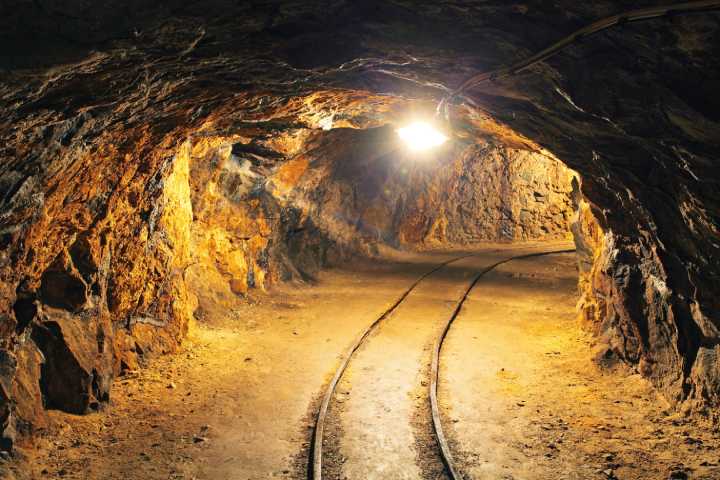While there are several gold mines in India, only a handful are operational, and a few have active gold mine leases.
With a rich history of gold mining and its immense value in Indian society, the country remains one of the top consumers of gold.
In Indian culture, gold is more than just a precious metal; it is sacred and has profound cultural importance, symbolizing wealth and prosperity.
Most of the gold deposits in India are concentrated in the states of Karnataka and Rajasthan, along with significant deposits in Andhra Pradesh, Jharkhand, and Bihar.
In 2023-24 financial year, India’s gold production is expected at 1341 Kg, slightly decreasing compared to 1430 Kg in 2022-23.
Let’s dive deep into the details of Gold mines in India, their significance, and the mining details.


1. Hutti Gold Mines, Karnataka
Located in the Raichur district of Karnataka, Hutti Gold Mine is the largest operating mine in India.
A total of 38,56,300 tonnes of ore was extracted from this mine, yielding 26,550 kilograms of gold, with an average recovery of 6.88 grams of gold per tonne.
The Hutti Gold mine deposits are spread across a 65-kilometre stretch of the Hutti-Maski greenstone belt.
This is one of the most ancient metal mines in the world, dating back to the 3rd century BCE.
Besides, the ancient mining, which was done extensively in this belt, the mining got continued and eventually disappeared by 600 AD.
In the 18th century, the Deccan Company undertook the mining efforts for the Nizam of Hyderabad.
Later, John Taylors and Sons operated the mining activities in Hutti until 1920, when World War I led to the mine’s closure.
Following state reorganization in 1956, the authorities renamed these mines as The Hutti Gold Mines Company Limited (HGML).
Since then, Hutti Mines has continued gold production, even after the main mine closed because of waterlogging.
Four mine shafts located in different areas service this mine.
During the year 2022-2023, Hutti Gold mines produced 1.41 tonnes of Gold compared to 1.23 tonnes in 2021-22.
Hutti is the biggest among the active gold mines in India and accounts for 99% of the gold production in India.
2. Kolar Gold Fields, Karnataka
The popular Kolar Gold Fields are located in the Kolar district of Karnataka is the Biggest Gold mine in India. It is one of the ancient gold mines in India that dates to the 1st century BCE.
A greater mining activity had happened during the Gupta period in the 5th century AD and later in the British period.
The Kolar Gold Fields have produced 800 tonnes of gold in over 120 years. It had yielded 47 grams of Gold per tonne on average from 1881 to 1890, which is one of the highest in the world. Later it had fallen to 3.14 grams during 1991-1999.
In 1972, this mine was handed over to Bharat Gold Mines Limited (BGML), which works under the ministry of mines.
Later, in 2001, rising costs and environmental factors led to the closure of gold mines in KGF.
In 2013, the Government of India took a decision to invite global tenders for the reopening of mines at Kolar Gold fields.
In June 2024, the state government of Karnataka also approved the central government’s proposal to revive mining activities on tailing dumps at the defunct Bharat Gold Mines Limited Mine.
At present, BGML has 24 tonnes of Gold in its tailing sand with a gold content of 0.72 grams/tonne.
3. Jonnagiri Gold Mines, Andhra Pradesh
Owned by the Deccan Gold Mines and Geo Mysore Services, The Jonnagiri Gold Mines are present in Jonnagiri, Pagadrayi, and Yerragudi Villages of Kurnool district in Andhra Pradesh.
This is the first large-scale private gold mines in India. It is also one of the most well-developed and advanced gold mining projects in India.
Geomysore services had done detailed works, evaluated, and said that the open pit of the east block of Jonnagiri mines has 6.8 million tons of Mineable Gold.
They also mentioned that detailed drilling in another block could even increase the potential mineable Gold to 14 million tonnes.
Gold present in Jonnagiri mines is free milling type and is present with sulphites, which are visible in quartz veins and stringers.
Pilot scale production in this project has already commenced and will soon start commercial production.
4. Ganajur Gold Mine, Karnataka
Deccan Exploration Services Private Limited (DESPL) had started exploring the Ganjanur area and discovered this mining field in Karnataka.
Gunjanur Gold Mine is an open pittable gold mine with 15.3 Million tonnes of ore having 3.79 grams of gold per tonne. This accounts for the total gold deposits of 5.8 Tonnes of Gold in the Ganajur gold mine.
The mining method employed is conventional open pit mining, which involves activities like load, haul, and drill blast.
These minefields can provide 500 jobs, positively impacting the local livelihoods.
5. Ramagiri Gold Fields, Andhra Pradesh
Located in the Anantapur district in Andhra Pradesh, the Ramagiri Gold Belt has three highly explored blocks that are identified as worthy of mining.
They are Ramagiri Gold Field, Boksampalle block, and Ramagiri West block. The entire Ramagiri belt was still unexplored.
However, the historical evidence of the recovery of 15 grams of Gold per tonne makes it one of the valuable Gold mines in India.
Gold mineralization here is associated with stringers and veinlets of quartz, as well as quartz-carbonate veins that are localized in Phyllite.
During the British rule, extensive mining operations at the Ramagiri Gold fields yielded 49.99 tonnes of gold (176,338 ounces).
GSI (Geological Survey of India) had reported gold resources of 5.90 Lakh tonnes of ore having 3.7 grams gold/tonne.
Further, GSI had also reported inferred resource of 39.6 Lakh tonnes of ore with an average grade of gold varying from 1.32 to 5.6 grams per tonne of ore.
Gold mine in this region was first operated from 1905 to 1927 by John Taylor & Sons.
Deccan Gold Mines Limited currently holds the lease for the Ramagiri Gold Field PL Block.
6. Ajjanahalli Gold Mines and Chitradurga Gold Belt, Karnataka
Present in Tumkur District, Ajjanahalli gold mines are a well-known area with gold deposits in the state of Karnataka.
This gold mine is explored by GSI and HGML. The HGMl carried out mining through an open-cast mine from 1995 to 2002. However, they had stopped mining activity during 2002 due to non-viability.
HGML had recovered 963.4 Kg of gold from 6 Lakh tonnes of ore.
At the same time, between 1998 and 2018, mining activities had carried out in other regions of the Chitradurga Gold Belt.
The Geological Survey of India explored the Ajjanahalli gold mines area and reported a total of 7.34 million tonnes of gold ore, with an average grading of 1.43 grams of gold per tonne.
7. Sonbhadra Mine Fields, Uttar Pradesh
The Sonbhadra Mine Fields in Uttar Pradesh has reserves of 160 kg of Gold.
These Goldfields gained a massive attraction when the local geology and mining department claimed the discovery of 3000 tonnes of gold deposits in the Sonbhadra district in 2020.
However, the Geological Survey of India has rejected the claims, stating the gold reserves stand at 160 Kg in Sonbhadra mine fields. The total ore present for extracting the Gold is 52806.25 tonnes.
The mineralized zone has an average of 3.03 grams of gold per tonne.
8. Chigaragunta Gold Mine, Andhra Pradesh
Present in the Jarugakonda in the Chittoor district of Andhra Pradesh, the Chigaragunta Gold Mine has good gold deposits among the Gold mines in India.
These mines have a total reserve of approximately 8.5 million tonnes as per NMDC (National Mineral Development Corporation).
NMDC got the bid for this gold mine through e-auction. The corporation had offered 38.25% revenue share on the sale value to the government.
This mine will be operated as an underground mine.
One of the promising blocks in this mine is the Bisanatham gold block, which covers an area of 263.01 hectares.
Mining corporations expect this block to contain 1.73 million tonnes of gold ore, with each tonne having 4.70 grams of gold.
The Chigaragunta block has 2.04 million tonnes of reserves with an average of 5.73 grams of gold per tonne up to the 5th level.
9. MallapaKonda Gold Deposit, Andhra Pradesh
The Mallapakonda Gold deposits are located in the southern part of the Kolar Schist belt in the Chittoor district of Andhra Pradesh.
Gold in this mine is refractory type, and the mineralization occurs in sulphidic BIF.
Exploration by MECL had established that this mine has 0.773 Mt of gold ore containing 2.47 grams of gold per tonne of ore.
Mallappakonda mine can be operated in a combination of open pit and underground mining.
10. Chinmulgund Gold Mines, Karnataka
Located in the Haveri district of Karnataka, Chinmulgund gold mines are a part of the Dharwar- Shimoga Schist Belt.
Gold mineralization is confined to banded Magnetite Quartzite (BMQ), which has an average width of 8.5m.
As per MECL, 1.36 Mt of gold ore reserves are present in this mine, with 4.50 grams of gold per tonne.
11. Kempinkote Gold Fields, Karnataka
These ancient gold mines, which are long-forgotten are gaining attention as MECL seeks to rejuvenate the inactive mining blocks.
Kempinakote gold fields are located 6 km away from Shravanabelagola, a historical site in Karnataka.
These mines were active in the 18th century. However, shut down due to financial losses.
Villagers in this mine area and from surrounding regions are opposing the revival of the mines out of concern for losing their homes due to mines.
Gold present in these mines is in its native state, and there are six lodes in this block.
The MECL ore resource estimate is 1.385 Million tonnes with an average grade gold of 2.70 grams per tonne of ore.
12. Parasi Gold Mines, Jharkhand
Renowned for its mineral resources, The Gold deposits of Parasi in Jharkhand are located 60 km southeast of Ranchi.
This region contains an estimated 11.18 million tonnes of gold ore, with each tonne yielding 1 gram of gold.
As per the Mineral Exploration Corporation, the central block, 12 km south of Tamar, holds 7.467 million tonnes of gold reserves.
This mine is auctioned to Rungta Mines Limited, a renowned mining company, for INR1200 crores by the Jharkhand Government.
However, since the auction, it has been a focal point of controversy and protests from locals.
These mines are at a complex intersection of economic interests, community rights and environmental concerns, just like several other mines.
Gold in these mines is mainly present in disseminations, specks, streaks and fracture fillings along the shear planes.
13. Pahardia Gold Deposits, Jharkhand
The Pahardia Gold deposit is located in the Pahardia, Rungikocha, and Tentadih villages in Singhbhum district in Jharkhand.
The DGPS ETS survey indicates that the area spreads across 279.6 hectares, holding total reserves of 1.162 million tonnes, with each tonne containing 2.12 grams of gold.
This region is very mineral rich and contains other metals like Silver, Copper, Lead, Zinc and Nickel.
Gold mineralization in these mines is associated with quartz veins and silicified zones.
14. Gadag Gold Mine, Karnataka
The Gadag region in Karnataka has a long history of gold mining and quarrying.
Gold mineralization in Gadag occurs in shear zones, and is mostly free milling type.
As per MECL, The Gadag Schist belt has a total of 3.345 Million tonnes of gold ore deposits with a grading of 2.58 grams of gold per tonne.
15. Bhukia – Jagpura Gold Mine, Rajasthan
Located in the state of Rajasthan, the Bhukia-Jagpura gold mine one of the massive gold mines in India that has estimated ore resources of 113.52 million tonnes as per GSI.
But the gold ore in this mine has 0.5 grams gold per tonne.
The Bhukia-Jagpura gold mine spans 940.26 hectares and is allotted to Syed Owais Ali firm, which won the auction with a premium of 65.30%.
Gold occurs in these mines as a native metal in arsenopyrite, loellingite, and within pyrrhotite.
Government anticipates that this mine will generate good employment in this region.
16. Lawa Gold Mines, Jharkhand
Situated in the Lawa village of Jharkhand’s Saraikela district, Manmohan Mineral Industries owns the Lawa Gold Mines.
These mines are identified as a promising site for gold extraction and exploration.
Gold mineralization in this mine is highly present along the shear zone.
17. Wayanad-Nilambur Gold deposits, Kerala
The Wayanad – Nilambur Region in Kerala has a unique place in the history of gold mines in India.
This region has several gold deposits like the Waynad Gold Fields and Madura Gold Deposit.
There were 33 mining companies established in this region during 18th century. However, most firms incurred huge losses as the gold extracted in this region hadn’t reached maturity.
Later, most of these mining firms moved to KGF in the late 18th century.
An investigation by the Geological Survey of India on the Wayanad Goldfield highlighted the need for more in-depth studies to assess whether the project is economically feasible.
The department of mining and geology in Kerala conducted a detailed investigation and discovered 0.55 million tonnes of gold ore containing 4 grams of gold per tonne in Marudp and Nilambur, located in the Malappuram District.
They also highlighted the need for additional exploration with insights into the economics of commercial mining.
18. Kunderkocha Gold mines, Jharkhand
Although Kunderkocha gold mine is a very small gold mine in India that spans 19.5 Hectares with 0.007 metric tonnes of ore.
It became popular due to the presence of 13.11 grams of gold in a tonne of gold reserves in the Porojharna block.
Gold mineralization is found in smoky quartz veins. These mines are located in W. Singhbhum district in Jharkhand.
19. Bhitar Dari Gold Deposit, Jharkhand
Another gold reserve in Jharkhand, The Bhitar Dari gold deposit, is present in East Singhbhum district.
Geological Survey of India had identified a 250 Kg gold reserve beneath Bhitar Dari village, which is present 20 km south of Jamshedpur.
20. Hira-Buddini Gold Mine, Karnataka
This Hira Buddini Gold Mine is present 25 km south of Hutti in the Hutti Maski greenstone belt in Karnataka.
Geologists have identified five lodes in this mine, with two lodes, Molpa and main lodes, being persistent.
Estimates indicate that the Mopla lode contains 0.21 Mt of ore with 2.16 grams of gold per tonne.
Other Gold Mines in India and new explorations
Alongside these gold mines, there are several other gold mines and deposits in India, like the
- Dadam Gold Mine, Haryana
- Sonakhan Gold Deposit, Chhattisgarh
- Saleemanabad, Madhya Pradesh
- Wandalli and Uti gold mine blocks, Karnataka (linked to Hutti Gold mines)
Also, several explorations for finding and estimating the gold deposits are going on all over India, in states like Odisha, Andhra Pradesh, Bihar, and Karnataka.









